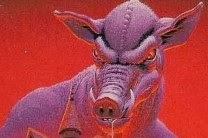A Touch of the Folkloric
 I'm playing in a casual Dungeons & Dragons game with some old friends of mine. In our most recent session, the player characters were traveling by boat toward a frontier town the bulk of whose population had either died or fled the place thirty years prior as the result of a magical plague. The PCs had been warned beforehand that one of the consequences of this large-scale abandonment was that many of the town's domesticated animals had gone feral and now posed a threat to travelers in the area. The characters were also told to be especially concerned about feral pigs, some of whom, it was said, had taken to walking on their hind legs and carrying weapons.
I'm playing in a casual Dungeons & Dragons game with some old friends of mine. In our most recent session, the player characters were traveling by boat toward a frontier town the bulk of whose population had either died or fled the place thirty years prior as the result of a magical plague. The PCs had been warned beforehand that one of the consequences of this large-scale abandonment was that many of the town's domesticated animals had gone feral and now posed a threat to travelers in the area. The characters were also told to be especially concerned about feral pigs, some of whom, it was said, had taken to walking on their hind legs and carrying weapons.
It's funny. This was just a small detail – a wild rumor given to the characters as they stopped by a village they passed on their way toward the aforementioned town. Yet, that rumor was terrifically evocative and compelling to me. It punched far above its weight as a throwaway explanation of the origin and nature of that stalwart D&D enemy, the orc. Admittedly, I've always been a fan of pig-faced orcs, but this little bit of background information grabbed me, so much so that, here I am, writing a post about it.
I think the reason this in-game rumor so seized my imagination is that it felt like something out of real world folklore, a horrific just-so story to explain the inexplicable. That's something D&D has rarely done at all, let alone done well. The game's approach to monsters, as exemplified by the Monster Manual, is too orderly, too rational, almost to the point of being scientific. That's the downside to Gygaxian Naturalism; it denudes the monsters of their montrosity by unambiguously laying out the truth of the matter in black and white. Come to think of it, the same is true of D&D's presentation of magic too, whether in the form of spells or magic items.
To some extent, this is inevitable. Dungeons & Dragons is a game and games have rules. Those rules need to be expressed as clearly as possible and doing so often militates against the sort of ignorance and mystery that's needed for good folklore. Fortunately, the rules of D&D have never been exemplars of clarity, which leaves space for the individual referee to put his own spin on things from time to time, as my friend did last night with his version of orcs. D&D – and fantasy RPGs generally – need more of this kind of thing.
Published on January 19, 2023 05:55
No comments have been added yet.
James Maliszewski's Blog
- James Maliszewski's profile
- 3 followers
James Maliszewski isn't a Goodreads Author
(yet),
but they
do have a blog,
so here are some recent posts imported from
their feed.



